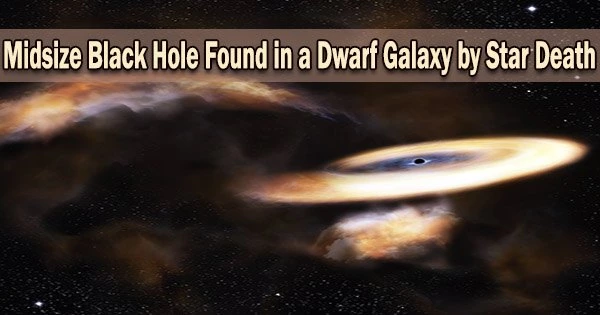Astronomers learned about an undetected intermediate-mass black hole in a dwarf galaxy when it devoured a star that got too close. The star’s destruction, referred to as a “tidal disruption event” or TDE, resulted in a flare of radiation that briefly outshone the host dwarf galaxy’s combined stellar light and may aid research into the interactions between black holes and galaxies.
Astronomers used the Young Supernova Experiment (YSE), a survey intended to find cosmic explosions and transient astrophysical events, to record the flare. An international team led by scientists at UC Santa Cruz, the Niels Bohr Institute at the University of Copenhagen, and Washington State University reported the discovery in a paper published on November 10 in Nature Astronomy.
“This discovery has created widespread excitement because we can use tidal disruption events not only to find more intermediate-mass black holes in quiet dwarf galaxies but also to measure their masses,” said coauthor Ryan Foley, an assistant professor of astronomy and astrophysics at UC Santa Cruz who helped plan the YSE survey.
First author Charlotte Angus at the Niels Bohr Institute said the team’s findings provide a baseline for future studies of midsize black holes.
“The fact that we were able to capture this midsize black hole whilst it devoured a star offered us a remarkable opportunity to detect what otherwise would have been hidden from us,” Angus said.
“What is more, we can use the properties of the flare itself to better understand this elusive group of middle-weight black holes, which could account for the majority of black holes in the centers of galaxies.”
All big galaxies, including the Milky Way, have supermassive black holes at their centers. These enormous monsters, with masses millions or billions of times more than that of the sun, may have developed from smaller “intermediate-mass” black holes, with masses of tens of thousands to millions of solar masses.
According to one theory, the early cosmos was filled with several small dwarf galaxies that contained intermediate-mass black holes. These dwarf galaxies would have merged or been swallowed up by larger galaxies over time, with each merger increasing the mass of the galaxy’s center. The supermassive black holes we observe today were eventually formed through this merger process.
“If we can understand the population of intermediate-mass black holes out there how many there are and where they are located we can help determine if our theories of supermassive black hole formation are correct,” said coauthor Enrico Ramirez-Ruiz, professor of astronomy and astrophysics at UCSC and Niels Bohr Professor at the University of Copenhagen.
But do all dwarf galaxies have midsize black holes?
“That’s difficult to assert because detecting intermediate-mass black holes is extremely challenging,” Ramirez-Ruiz said.
Black holes in the centers of dwarf galaxies are frequently invisible to traditional black hole hunting techniques, which look for actively feeding black holes. As a result, it is only known that a very small percentage of dwarf galaxies contain intermediate-mass black holes. The question of how supermassive black holes form might be resolved if more midsize black holes with tidal disruption events are discovered.
“One of the biggest open questions in astronomy is currently how supermassive black holes form,” said coauthor Vivienne Baldassare, professor of physics and astronomy at Washington State University.
The team was able to spot the first hints of light when the black hole started devouring the star thanks to information from the Young Supernova Experiment. Because the time of these events may be used to calculate the mass of the center black hole, capturing this initial moment was crucial to understanding how huge the black hole was.
This method, which until now had only been shown to work well for supermassive black holes, was first proposed by Ramirez-Ruiz and coauthor Brenna Mockler at UC Santa Cruz.
“This flare was incredibly fast, but because our YSE data gave us so much early information about the event, we were really able to pin down the mass of the black hole using it,” Angus said.
This study was based on data from observatories around the world, including the W. M. Keck Observatory in Hawaii, the Nordic Optical Telescope, UC’s Lick Observatory, NASA’s Hubble Space Telescope, the international Gemini Observatory, the Palomar Observatory, and the Pan-STARRS Survey at Haleakala Observatory.





